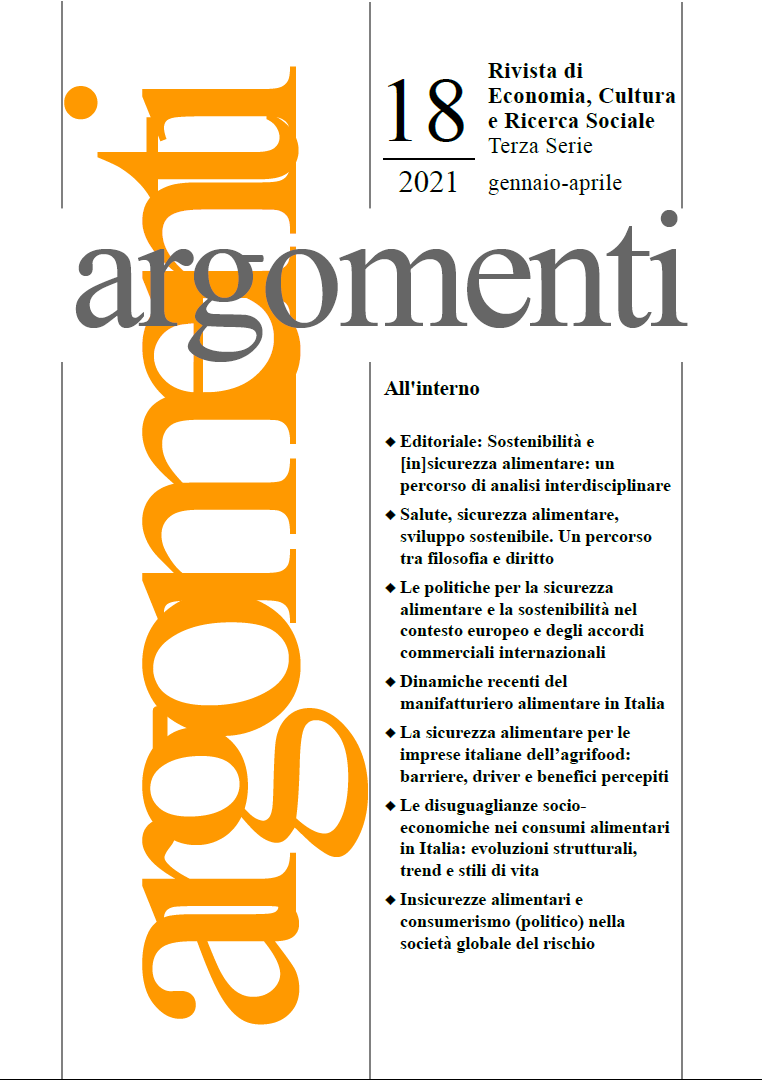Abstract
The objective of this paper is to present a picture of the evolution of food consumption in Italy, attempting to highlight the socio-economic factors that underlie the structural change in consumption and lifestyle of families. The main results, based on a survey conducted in 2021, show how the hypotheses according to which disadvantaged socio-economic and cultural conditions are linked, on the one hand, to more risky consumption habits and, on the other, to a more limited propensity to attribute relevance to choice criteria related to food safety or to environmental and political dimensions, do not seem to find support.
References
Abnet, C., Corley, D.A., Freedman, N.D. e Kamangar, F. (2015). Diet and upper gastrointestinal malignancies. Gastroenterlology, 148(6), 1234-43. Doi: 10.1053/j.gastro.2015.02.007.
Allcott, H., Diamond, R., Dubé, J.P., Handbury, J., Rahkovsky, I. e Schnell, M. (2019). Food Deserts and the Causes of Nutritional Inequality. The Quarterly Journal of Economics, 134 (4), 1793–1844. Doi: https://doi.org/10.1093/qje/qjz015.
Banca d’Italia, Relazione Annuale, 2020.
Bai, Y., Alemu, R., Block, S.A., Headey, D. e Masters, W.A. (2021). Cost and affordability of nutritious diets at retail prices: Evidence from 177 countries. Food Policy, 99(C). Doi: 10.1016/j.foodpol.2020.101983.
Ceccarini, L. (2021). The Digital Citizen(ship): Politics and Democracy in the Networked Society. Cheltenham, Edward Elgar Publishing.
Censis (2010). Primo Rapporto sulle abitudini alimentari degli italiani.
Censis (2016). Gli Italiani a tavola: qualcosa sta cambiando, il valore sociale dell’alimento carne e le nuove disuguaglianze.
Cicatiello, C., Marino, D. e Franco, S. (2011). Un focus sui consumatori che frequentano i farmers’ market. In Cersosimo, D. (a cura di), I consumi alimentari: evoluzione strutturale, nuove tendenze, risposte alla crisi. Roma, Edizioni Tellus.
Choi, S.C., Coughlan, A.T. (2006). Private label positioning: quality versus feature differentiation from the national brand. Journal of Retailing, 82, 79–93. Doi: https://doi.org/10.1016/j.jretai.2006.02.005.
Confcommercio, Ufficio studi, (2020). Qualche considerazione sulla dinamica della spesa per i prodotti alimentari in Italia.
Conforti, P., Pierani, P. e Rizzi, P.L. (2000). Food and nutrient demands in Italy. Actual behavior and forecast through a multistage quadratic system with heterogeneous preferences. Quaderno n. 303, Dipartimento di Economia Politica, Università di Siena.
Del Gobbo, L., Khatibzadeh, S., Imamura, F., Micha, R., Shi, P., Smith, M., Myers, S.S. e Mozaffarian, D. (2015). Assessing global dietary habits: a comparison of national estimates from the FAO and the Global Dietary Database. The American Journal of Clinical Nutrition, 101 (5), 1038–1046. Doi: https://doi.org/10.3945/ajcn.114.087403.
De Stefano, F. (2009). Problematiche economico-sociali nei Paesi avanzati sulla rintracciabilità e sulla sicurezza delle produzioni agroalimentari. In D’Amico, M. e Lanfranchi, M. (a cura di), Produzioni agroalimentari tra rintracciabilità e sicurezza, Atti del Convegno XLIV SIDEA.
Drabik, D., de Gorter, H. e Reynolds, C. (2019). A conceptual and empirical framework to analyze the economics of consumer food waste. Resources, Conservation and Recycling, 149, 500-509. Doi: 10.1016/j.resconrec.2019.06.008.
FAO (2015). The State of Food Insecurity in the World 2015. Meeting the 2015 International Hunger Targets: Taking Stock of Uneven Progress [Internet]; Food and Agriculture Organization of the United Nations. International Fund for Agricultural Development. Rome, Italy, 2015.
FAO (2019). The State of Food Security and Nutrition in the World 2019: Safeguarding against Economic Slowdowns and Downturns. Rome, Italy, 2019.
Hackner, J. (2000). A Note on Price and Quantity Competition in Differentiated Oligopolies. Journal of Economic Theory, 93(2), 233-239. Doi: https://doi.org/10.1006/jeth.2000.2654.
Irala-Estévez, J.D., Groth, M., Johansson, L., Oltersdorf, U., Prättälä, R. e Martínez-González, M.A. (2000) A systematic review of socio-economic differences in food habits in Europe: consumption of fruit and vegetables. European Journal of Clinical Nutrition, 54(9), 706-14. Doi: 10.1038/sj.ejcn.1601080.
Kozlova, O. (2016). Is healthy food a luxury for the low-income households in the U.S.? Job market paper, https://econ.duke.edu/sites/econ.duke.edu/files/job-market-papers/jmp_abstract_okozlova_1020.pdf.
Lallukka, T., Laaksonen, M., Rahkonen, O., Roos, E. e Lahelma, E. (2007). Multiple socioeconomic circumstances and healthy food habits. European Journal of Clinical Nutritrion, 61:701-10. Doi: 10.1038/sj.ejcn.1602583.
Long, M.A., Gonçalves, L., Stretesky, P.B. e Defeyter, M.A. (2020). Food Insecurity in Advanced Capitalist Nations: A Review. Sustainability, 12, 3654. Doi : https://doi.org/10.3390/su12093654.
Malassis L. (1979). Economie agro-alimentaire – Vol. I: Economie de la consommation et de la production agro-alimentaire. Paris, Cujas.
Marra, M., Migliardi, A. e Costa, G. (2015). Disuguali a tavola, ma non troppo: le differenze sociali nell’alimentazione in Italia prima e durante la crisi. Epidemiologia e Prevenzione, 39(5-6), 322-331.
Micheletti, M. e McFarland, A.S. (2011). Creative Participation: Responsibility taking in the Political World. Boulder, Paradigm Publishers.
Novaković, R., Cavelaars, A., Geelen, A., Nikolić, M., Altaba II, Viñas, B.R., Ngo, J., Golsorkhi, M., Medina, M.W., Brzozowska, A., Szczecinska, A., de Cock, D., Vansant, G., Renkema, M., Majem, L.S., Moreno, L.A., Glibetić, M., Gurinović, M. van't Veer, P. e de Groot, L.C. (2014). Socio-economic determinants of micronutrient intake and status in Europe: a systematic review. Public Health Nutrition, 17(5), 1031-45. Doi: 10.1017/S1368980013001341.
Petersen, K.E., Johnsen, N.F., Olsen, A., Albieri, V., Olsen, L.K., Dragsted, L.O., Overvad, K., Tjønneland, A. e Egeberg, R. (2015). The combined impact of adherence to five lifestyle factors on all-cause, cancer and cardiovascular mortality: a prospective cohort study among Danish men and women. British Journal of Nutrition, 113(5), 849-58. Doi: 10.1017/S0007114515000070.
Pinstrup-Andersen, P. (2009). Food Security: Definition and Measurement. Food Security, 1, 5–7. Doi: https://doi.org/10.1007/s12571-008-0002-y.
Romano, D. (2011). L’evoluzione strutturale dei consumi alimentari in Italia. In I consumi alimentari, atti del workshop tenuto a Palazzo Rospigliosi, Roma, Settembre.
Stolle, D. e Micheletti, M. (2013). Political Consumerism. Global Responsibility in Action. New York, Cambridge University Press.
Tarrazo-Antelo, A.M., Ruano-Ravina, A., Abal Arca, J. e Barros-Dios, J.M. (2014). Fruit and vegetable consumption and lung cancer risk: a case-control study in Galicia, Spain. Nutrition and cancer, 66(6): 1030-7. Doi: 10.1080/01635581.2014.936951
World Health Organization (2006). Comparative analysis of nutrition policies in the WHO European Region. WHO: Copenhagen, Denmark.
Zamagni, S. (2006). Sicurezza alimentare, sviluppo sostenibile, qualità. In Martino, G., , C. e Sediari, T. (a cura di), La sicurezza degli alimenti. Contributi all’analisi economica (pp. 7-15). Roma, Donzelli.

This work is licensed under a Creative Commons Attribution 4.0 International License.
Copyright (c) 2021 Argomenti





